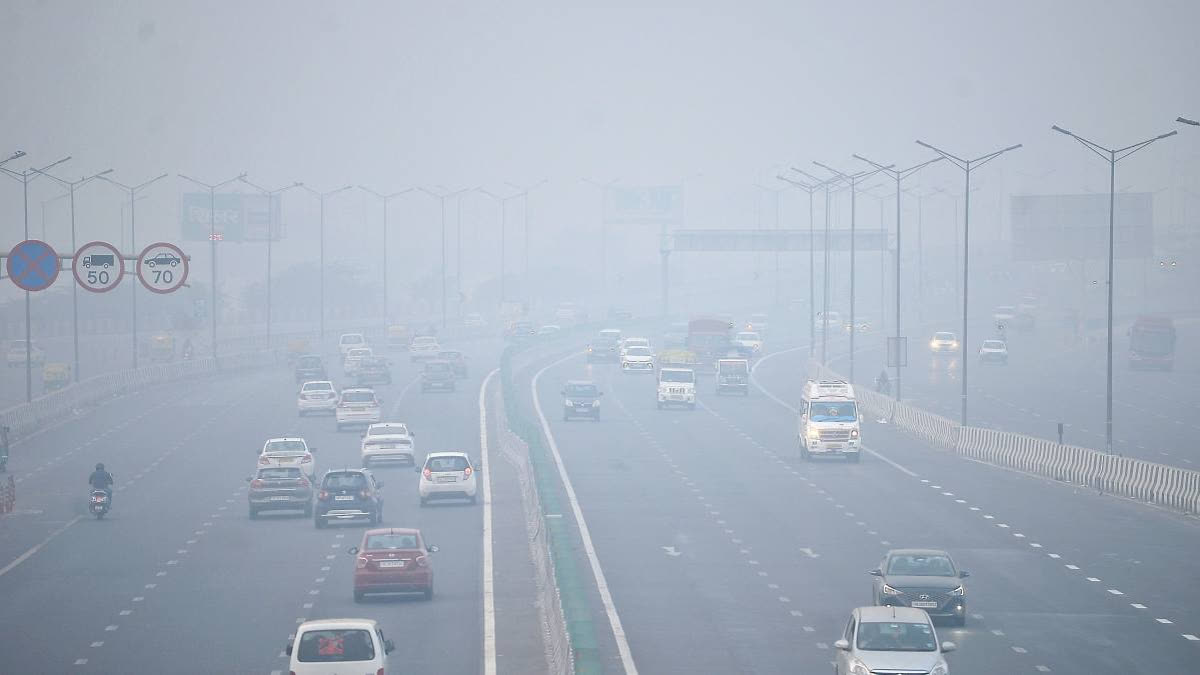New Delhi: Delhi and its surrounding National Capital Region (NCR) are grappling with severe air pollution, with the Air Quality Index (AQI) in several areas crossing the 400 mark on Saturday.
The AQI at Delhi’s Shadipur recorded an alarming 457 (‘severe plus’) at 9 am, while Narela (449), Wazirpur (441), and Jahangirpuri (445) also reported critical levels of pollution, according to the Central Pollution Control Board (CPCB).
This marks the fourth consecutive day of smog engulfing the national capital, Noida, Ghaziabad, Gurugram, and nearby regions.
A local told ETV Bharat, “Cycle is better than a car, it is a little comfortable for the body and it also provides some exercise. Pollution is causing problems, like difficulty in breathing."
"Pollution happens every year but you and I can't do anything about it. The government should find solutions to this pollution. I will say this to the government. Find a solution to this pollution as this is a problem every year. But if the government is not doing anything effective then what we can't do anything about it, the local added.”
Stringent Measures Enforced to Combat Pollution
In response to the deteriorating air quality, the Delhi government has implemented stringent vehicle restrictions. The operation of BS-III petrol and BS-IV diesel four-wheelers has been banned across the city, with violators facing a penalty of ₹20,000 under Section 194(1) of the Motor Vehicle Act, 1988.
Diesel Medium Goods Vehicles (MGVs) meeting BS-III standards or below are also prohibited unless transporting essential goods. Interstate buses powered by electric, CNG, or BS-VI diesel engines are exempt, while others remain banned unless operating under an All India Tourist Permit.
Graded Response Action Plan (GRAP-III)
The Commission for Air Quality Management (CAQM) has invoked the third phase of the Graded Response Action Plan (GRAP-III), introducing various measures to mitigate pollution:
1. Road Cleaning and Sprinkling: Intensified road sweeping and water sprinkling operations have been initiated, targeting pollution hotspots and high-traffic areas.
2. Construction Ban: All private construction and demolition activities have been suspended. However, essential government infrastructure projects continue unaffected.
3. Public Transport Enhancement: To reduce vehicular emissions, 106 additional shuttle buses have been deployed, and metro train services have been increased.
Changes in Office Timings and School Operations
To ease traffic congestion and reduce pollution, Delhi Chief Minister Atishi announced staggered office timings for government employees. Central government offices will operate from 9 am to 5:30 pm, Delhi government offices from 10 am to 6:30 pm, and Municipal Corporation of Delhi (MCD) offices from 8:30 am to 5 pm. This measure, approved by Delhi LG VK Saxena, will remain in place until February 2025.
Schools for students up to Class 5 will switch to online learning starting next week, aiming to protect children from hazardous air quality.
Contributions to Pollution
According to the Centre’s Decision Support System for Air Quality Management, stubble burning accounted for 33.3 per cent of Delhi’s pollution on Thursday, making it the largest contributor. Vehicular emissions added 11.9 per cent to the pollution levels on Friday.
The primary pollutant identified by CPCB is PM2.5— microscopic particles that can penetrate deep into the lungs and enter the bloodstream, posing serious health risks.
Impact on Air Travel
Poor visibility due to dense fog and smog has severely disrupted air travel. At Chandigarh’s Shaheed Bhagat Singh International Airport, three flight arrivals—two from Delhi and one from Bengaluru—were cancelled, while others were delayed by three to four hours.
Flights from Pune and Bengaluru to Chandigarh were diverted to Jaipur, and an Abu Dhabi-Chandigarh flight was rerouted to Delhi. Departures to Lucknow, Hyderabad, Chennai, Patna, Bengaluru, and Mumbai faced delays of two to three hours, with visibility issues persisting throughout the day.
Health and Environmental Concerns
The prominent pollutant PM2.5 continues to endanger public health, with its microscopic size allowing it to infiltrate respiratory and circulatory systems. Residents are advised to limit outdoor activities, use air purifiers indoors, and wear N95 masks when venturing outside.
Way Forward
While restrictions and measures under GRAP-III are a step forward, experts emphasize the need for long-term solutions to combat Delhi’s recurring air quality crisis. Transitioning to cleaner fuels, improving public transportation, and reducing stubble burning through sustainable agricultural practices remain critical to addressing this pressing issue.
Read More
AQI 408: Delhi Spews Toxic Air, People Fune Over Lack of Effective Pollution Control Measures
Delhi Pollution: Why Has Air Quality Deteriorated? Know When Conditions Will Improve
Chandigarh Ranks Among India's Most Polluted Cities With AQI In 'Very Poor' Category



